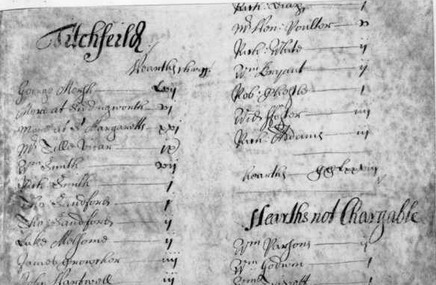Hearth Tax Rolls ~ 1664





The hearth tax, also known as hearth money, chimney tax, or chimney money, was a tax imposed by Parliament in 1662, to support the Royal Household of King Charles II. Following the Restoration of the monarchy in 1660, Parliament calculated that the Royal Household needed an annual income of £1,200,000. The hearth tax was a supplemental tax to make up the shortfall. It was considered easier to establish the number of hearths than the number of heads, hearths forming a more stationary measure than people. This form of taxation was new to Ireland, but had precedents abroad. It generated considerable debate, but was supported by the economist Sir William Petty. The bill received Royal Assent on 19 May 1662, with the first payment due on 29 September 1662, Michaelmas.
One shilling was liable to be paid for every firehearth or stove, in all dwellings, houses, edifices or lodgings, and was payable at Michaelmas, 29 September and on Lady Day, 25 March. The tax thus amounted to two shillings per hearth or stove per year. The hearth tax was intended to be fair, in that it fell more heavily upon those with multiple or larger residences, but there were practical difficulties. The original bill did not distinguish between owners and occupiers and there were no exemptions. The bill was subsequently amended so that the tax was paid by the occupying family or household. Further amendments introduced a number of exemptions.
Revenue generated in the first year was less than expected, so from 1663, the names and number of hearths were required to be listed even if non-liable. This additional detail has made the hearth tax documents useful to modern historians and researchers. From 1664, everybody with more than two hearths was liable, even if otherwise exempt, and there were clauses which reduced the scope for tax avoidance.
Exemptions from the Hearth Tax were those:
Not paying Poor or Church Rates
Inhabiting a house, tenement or land worth less than 20 shillings (£1) rent per annum
Assets worth less than £10
Private ovens, furnaces, kilns and blowing houses
Hospitals and almshouses where revenue less than £100 per annum.
What had started out as a simple idea, perceived to be fair, had become over-complicated and bureaucratic. It was administered by receivers known as "Chimney Men", aided by sub-collectors and petty constables. Exemption certificates had to be signed by a minister, a churchwarden, or an overseer of the poor and two Justices of the Peace, and was clearly not targeting the wealthier people with multiple or larger properties, as originally intended. Wealthy landowners and landlords, who could best afford the tax, were exempt as the tax was now being paid by their tenants. The landowners were often MPs or had links with the Royal Household and were seen as being in a good position to amend the original bill to their advantage.
The hearth tax was therefore much resented by those upon whom it fell, typically the middle classes. The tax was also resented because it entailed inspection of every dwelling by the sub-collectors and petty constables, who had legal authority to enter every property and inspect the number of hearths.
Some people stopped up their chimneys so that the tax was not due on them, but where this was discovered by the assessors the tax was doubled. The Hearth tax was repealed by William and Mary in 1689, at least in part as a bid for popularity after their accession to the throne as a result of the Revolution of 1688. It remained in force in the Kingdom of Ireland, being the most convenient way to tax the poor, and was finally abolished in 1795 to prevent unrest inspired by the French First Republic.
We are currently building a database of names in all of the records shown here, but as you can probably imagine, this is a mammoth task and we are adding new names daily. You can search through the names available in the search engine below. If you have any records for the Lurgan area that you would like us to publish here, please contact us via the link below.
We make this information freely available to genealogists and Family Historians, but at no time may this information be used on a pay site or sold for profit.
Click on an area on the right to see the records, or type a surname in the search box below.


|

